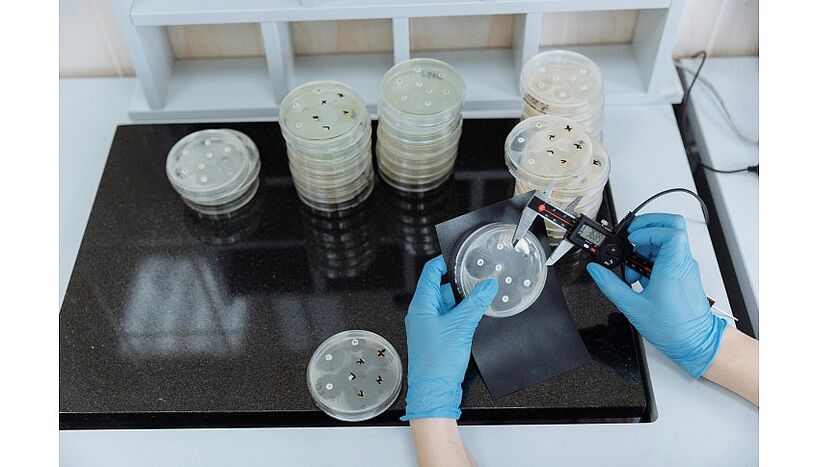
Fig. 1: C: Pexels / Thirdman
The novel glycopeptide saarvienin A is highly effective against resistant pathogens
An international team of researchers, led by the University of Vienna and the Helmholtz Institute for Pharmaceutical Research Saarland, has discovered saarvienin A, a new type of glycopeptide antibiotic. Their findings, now published in Angewandte Chemie International Edition, introduce a compound with strong activity against highly resistant bacterial strains.
Antibiotic-resistant infections are on the rise, threatening to make even common diseases deadly again. Without new antibiotics, experts warn that up to 100 million lives could be lost annually by 2050. In search for new compounds, researchers from several institutions, including the University of Vienna and the Helmholtz Institute for Pharmaceutical Research Saarland (HIPS), have turned to the study of actinobacteria - microorganisms that are well-known for living in unusual environments and producing antibiotics such as vancomycin, rifamycin, and chelocardin. Jaime Felipe Guerrero Garzón from the Division of Pharmacognosy at the University of Vienna's Department of Pharmaceutical Sciences, discovered strong antibiotic activity in extracts from a strain of Amycolatopsis isolated from a Chinese rare earth mine, which prompted further investigation. Martin Zehl, Head of the Mass Spectrometry Center at the University of Vienna, found out that this antibiotic activity was associated with a potentially novel compound of the class glycopeptides. Using mass spectrometry and nuclear magnetic resonance (NMR) spectroscopy, the collaborating team at HIPS identified a completely new molecule: saarvienin A.
Breaking the rules: A glycopeptide with a twist
Saarvienin A's special feature became clear early on: unlike established glycopeptides such as vancomycin, the new compound does not bind the typical bacterial target involved in cell wall synthesis. Instead, it probably acts through a different, as yet unresolved mechanism. Structural analysis revealed a distinctive architecture: a halogenated peptide core cyclized through an unusual ureido linkage, decorated with a chain of five sugar and aminosugar units - two of which are completely new to natural products. "We were excited to find that saarvienin A doesn't fit into any known category," said Jaime Felipe Guerrero. "Its unique structure could pave the way for antibiotics that bacteria have never encountered before."
A strong weapon against resistant bacteria
In close collaboration, researchers at HIPS, led by corresponding author Rolf Müller, characterized the biological activity of saarvienin A, named after Saarbrücken and Vienna. Tests of the new molecule against bacteria focused in particular on "ESKAPE pathogens" - a notorious group of superbugs known to evade most current antibiotics. The compound showed remarkable acivity against vancomycin-resistant Enterococcus and methicillin-resistant Staphylococcus aureus (MRSA), including 3 ESKAPE pathogens and 26 clinical isolates. It consistently outperformed vancomycin, even against strains already resistant to multiple other antibiotics. "Discovering a new antibiotic is only the beginning," said corresponding author Sergey B. Zotchev from the University of Vienna. "Now we face the fascinating challenge of refining it into a drug candidate suitable for clinical use."
Next steps: Engineering for the clinic
With the biosynthetic genes for saarvienin A already identified and cloned, the international team plans to use medicinal chemistry and biosynthetic engineering to optimize the molecule. A key goal is to reduce cytotoxicity while maintaining antibacterial activity. Although challenges remain, the discovery of saarvienin A provides much-needed momentum in the fight against antibiotic resistance - and highlights the potential of unexplored natural sources.
Original Publication:
Saarvienin A - A Novel Glycopeptide with Potent Activity against Drug-Resistant Bacteria. Amninder Kaur, Jaime Felipe Guerrero-Garzón, Sari Rasheed, Martin Zehl, Franziska Fries, Bernd Morgenstern, Sergey B. Zotchev, and Rolf Müller
In Angew. Chem. Int. Ed. 2025, e202425588.






